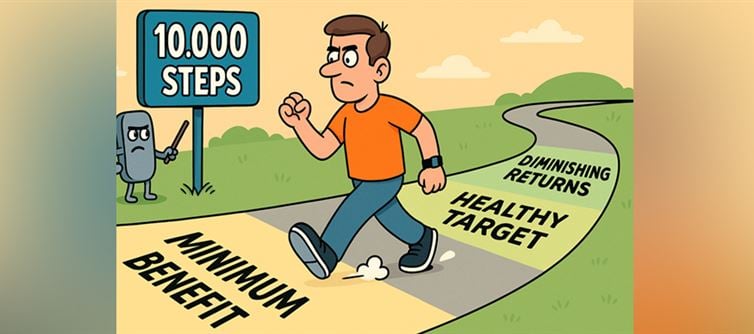
Every fitness app, smartwatch, and influencer chants the same gospel: “Walk 10,000 steps a day.”
But here’s the truth — that number didn’t come from a doctor, a scientist, or a research lab.
It came from a 1960s Japanese marketing campaign for a pedometer called Manpo-kei, which literally means “10,000 steps meter.”
Decades later, the world still treats that marketing slogan as medical advice.
But modern science is brutally clear: you don’t need 10,000 steps to live longer — you just need to move more than you do now.
🚶♂️ THE 10,000-STEP MYTH EXPOSED
The idea that 10,000 steps is some magical threshold for fitness is pure myth.
It’s not grounded in physiology or evidence — it’s grounded in advertising.
What research actually shows is this:
The health benefits of walking start around 4,000 steps per day.
You get most of the life-extending, disease-reducing benefits by 8,000 steps per day.
Beyond that? Diminishing returns.
So, if you’re stressing about hitting 10k, stop.
8k is the sweet spot.
Everything above is a bonus — not mandatory.
🧭 THE MINIMUM BENEFIT ZONE: 4,000 STEPS/DAY
If you’re barely moving — maybe 1,500 to 2,000 steps a day — even a small increase has a big impact.
Moving up to around 4,000 steps/day already lowers your risk of death, heart disease, and metabolic disorders compared to being sedentary.
The message?
Don’t chase perfection — chase progress.
Because every extra step counts more when you’re starting from zero.
💪 THE HEALTHY TARGET: 8,000 STEPS/DAY
Around 8,000 steps per day is where the magic happens.
Studies have shown this range offers the maximum risk reduction for:
heart disease
Diabetes
Obesity
Stroke
Early death from any cause
Think of 8,000 steps as your “low-risk zone.”
You’re doing enough for long-term health — without punishing yourself chasing arbitrary numbers.
It’s the difference between a sustainable habit and a burnout obsession.
⚖️ THE CEILING EFFECT: WHY MORE ISN’T ALWAYS BETTER
Beyond 8,000–10,000 steps, the benefits start to plateau.
You’ll still burn more calories, but your health markers (heart, blood sugar, mortality risk) barely improve further.
That’s called the ceiling effect — where doing more gives you smaller and smaller returns.
So, if you’re walking 12k steps every day, thinking it’ll make you immortal — relax. You’ve already hit the biological jackpot at 8k.
🩺 THE LIVER ANGLE: A HIDDEN BENEFIT
Here’s where it gets fascinating:
Recent studies show that walking around 8,000 steps per day can significantly reduce the risk of fatty liver disease — one of the most silent and deadly metabolic issues today.
Even increasing your steps from 2,000 to 5,000 can meaningfully cut the risk of liver fat buildup and inflammation.
So yes, your evening walk isn’t just good for your heart — it’s literally protecting your liver.
💬 WALK SMART, NOT MORE
You don’t need to walk for vanity metrics.
You need to walk for vitality.
The goal isn’t to hit a number. The goal is to build consistency.
Sedentary? Start at 4,000.
Active? Stay around 8,000.
Athlete? Go higher if you love it — but don’t fool yourself that “more” always means “healthier.”
Walking isn’t a punishment for calories.
It’s a reward for your body.
⚡ FINAL WORD: STOP COUNTING. START LIVING.
The 10,000-step rule was never science — it was sales.
What’s real is movement.
What’s sustainable is moderation.
Walk because you want to breathe better, think clearer, live longer.
Not because your smartwatch guilt-tripped you into it.
Your body doesn’t care about round numbers.
It cares about rhythm.
So ditch the myth.
Aim for progress — not perfection.
And remember: 8,000 steps is enough to outlive the lie.




 click and follow Indiaherald WhatsApp channel
click and follow Indiaherald WhatsApp channel